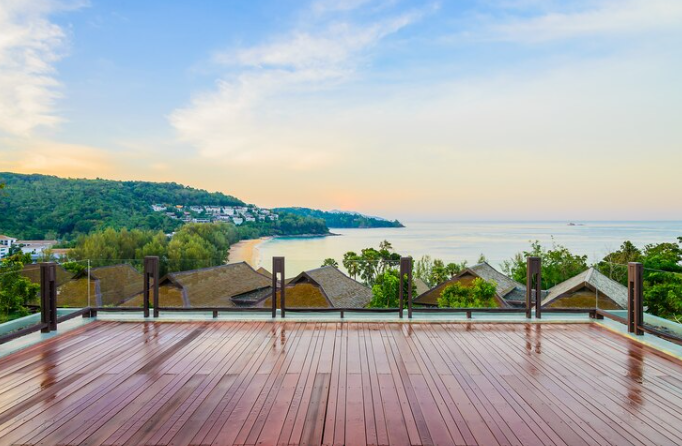
Wood, glass, and stone—three classic materials that are now teaming up to change the way outdoor spaces look and feel. This design trend is all about blending decks, walls, and sunrooms into one smooth, stylish flow.
The warmth of wood, the sleekness of glass, and the solid feel of stone come together to create spaces that are cozy yet modern, inviting yet fresh. It’s like the best parts of nature and architecture shaking hands to make your backyard or sunroom a spot you never want to leave.
Whether you’re relaxing or hosting, these materials work together to bring both style and function to your home’s outdoor vibe.
How are modern home additions blending natural materials like wood and stone?
Modern home additions blend natural materials like wood and stone to create cohesive, organic spaces that feel both contemporary and timeless. Rather than using these materials in isolation, today’s designs emphasize balance, texture, and connection to nature—resulting in additions that feel like natural extensions of the home and its surroundings. Here’s how designers are achieving this blend:
- Material Contrast and Harmony: Wood’s warmth softens stone’s solidity, while stone adds visual weight and texture to wood’s smooth grain. The contrast enhances depth and interest, while their natural origins keep the design grounded and unified.
- Indoor-Outdoor Continuity: Sunrooms, decks, and enclosed patios use wood beams, stone floors or accent walls, and large glass panels to bridge the indoor-outdoor divide, making transitions seamless and immersive.
- Biophilic Design Principles: Modern additions prioritize natural light, views, and organic materials to foster well-being. Exposed timber frames, stone hearths, and raw finishes create environments that echo the outdoors.
- Custom Craftsmanship: Artisans and builders integrate wood and stone in handcrafted details—like stone-wrapped columns with wood caps or mixed-material staircases—reflecting a return to bespoke, thoughtful design.
This blending of materials celebrates nature while delivering sophisticated, sustainable spaces that enhance form and function.
What impact does integrating glass into exterior structures have on design flow?
Integrating glass into exterior structures has a transformative impact on design flow, creating a seamless visual and spatial connection between indoor and outdoor environments.
Glass opens up a structure—both literally and stylistically—by allowing light, views, and natural elements to become part of the living experience. It softens boundaries, enhances openness, and elevates the overall sense of cohesion in modern architectural design. Here’s how glass influences design flow:
- Blurs Indoor-Outdoor Divides: Large glass panels, sliding doors, and sunroom enclosures visually and physically connect interiors to outdoor spaces like decks, patios, and gardens—encouraging movement and continuity.
- Amplifies Natural Light: Glass maximizes daylight penetration, brightening adjacent spaces and reducing the need for artificial lighting. This creates a more expansive, uplifting atmosphere throughout the home.
- Enhances Visual Harmony: Glass allows other materials—like wood beams or stone walls—to shine without visual interruption, maintaining a clean, fluid design language across connected structures.
- Supports Minimalist Aesthetics: With its transparency and clean lines, glass complements modern architecture, helping spaces feel less cluttered and more open.
- Creates Framed Views: Strategically placed glass elements act like picture frames for the landscape, making nature a central feature of the design.
Glass is the invisible thread that ties together architecture, light, and landscape—elevating design flow from room to horizon.
How do transitional spaces connect outdoor decks with indoor living areas?
Transitional spaces serve as architectural and experiential bridges connecting outdoor decks with indoor living areas, enhancing functionality and flow. They are designed to blur the boundaries between inside and outside, allowing homeowners to move effortlessly between environments while maintaining visual and stylistic continuity.
Here’s how transitional spaces make that connection:
- Sunrooms and Enclosed Patios: These partially indoor areas provide shelter while offering natural light and outdoor views, acting as an intermediate step between a full interior and an open deck.
- Large Sliding or Folding Glass Doors: Modern systems allow entire walls to open, transforming a living room into an open-air extension connected to a deck—creating one unified space.
- Covered or Pergola-Capped Areas: Roofed sections that extend from the home provide shaded, weather-resistant zones where indoor furnishings and outdoor ambiance meet.
- Consistent Materials and Design: Using similar flooring (like hardwood or composite), color palettes, and finishes across both spaces enhances the sense of continuity and cohesiveness.
- Shared Functionality: Transitional zones often house dual-purpose furniture or features—like outdoor kitchens, fireplaces, or lounges—that can be enjoyed from both sides of the threshold.
Transitional spaces create a fluid dialogue between nature and comfort, encouraging a lifestyle where indoor luxury and outdoor living coexist effortlessly.
What makes mixed-material architecture appealing in contemporary home layouts?
Mixed-material architecture is appealing in contemporary home layouts because it creates a dynamic, layered aesthetic while enhancing functionality and expressing individuality.
By blending materials like wood, metal, glass, stone, and concrete, designers achieve a rich visual contrast that adds depth and interest—far beyond what a single-material structure can offer. Here’s why it resonates with modern homeowners and architects:
- Visual Texture and Contrast: Combining natural and industrial elements (e.g., warm wood with cool steel or smooth glass with rough stone) creates visual balance and tactile interest, making spaces curated and multi-dimensional.
- Defined Zones Without Walls: Mixed materials help subtly define open-concept areas—like a stone accent wall anchoring a living space or a wood-paneled ceiling distinguishing a kitchen—without disrupting flow or light.
- Personalized Aesthetic: Using diverse materials allows homeowners to reflect their taste, whether it leans modern rustic, industrial-chic, or organic contemporary.
- Sustainable and Functional Choices: Designers can select materials for performance—like concrete for thermal mass or reclaimed wood for sustainability—without sacrificing style.
- Architectural Storytelling: Mixed-material layouts often reveal the evolution of space, echoing natural surroundings or historical influences through material choices.
Mixed-material architecture captures the spirit of modern living: flexible, expressive, and beautifully balanced between form and function.
Unite Indoors and Out with Natural Material Design
We specialize in seamlessly blending wood, glass, and stone to create stunning decks, walls, and sunrooms that feel connected to your home and the surrounding landscape. Our custom-crafted spaces balance warmth, light, and texture—delivering beauty, comfort, and lasting functionality.
Whether you’re expanding your outdoor living area or transforming a transitional space, we build with intention and artistry. Let Bull Mountain turn your vision into a cohesive, nature-inspired retreat that flows effortlessly from interior to exterior. Craft your perfect space with us today.








